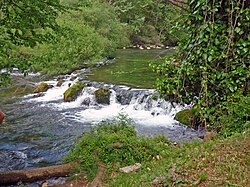| Jadro | |
|---|---|
 Jadro near Solin | |
| Location | |
| Country | Croatia |
| Physical characteristics | |
| Mouth | |
• location | Adriatic Sea |
• coordinates | 43°32′05″N 16°28′33″E / 43.5347°N 16.4757°E |
| Length | 4.5 km[1] |
The Jadro is a watercourse in Dalmatia, Croatia, that discharges into the Adriatic Sea. The upper reaches of the Jadro River, as well as its source, Jadro Spring, are protected as an ichthyological nature reserve, partly due to the presence of an endemic species of soft-mouthed trout.[2] The headwaters of the Jadro River were the original water supply for the ancient city comprised by Diocletian's Palace (now an area within the present day city of Split).[3] Contemporary studies indicate favourable water quality levels of the river near the headwaters at Jadro Spring.[4]
The Jadro flows through the town of Solin and has a length of approximately four kilometres' moreover, the river provides water to the cities of Split, Kaštela and Trogir as well as of municipalities Podstrana, Klis, Seget and Okrug.[5] Incompliances with the regulations related to water for consumption occasionally appear due to turbidity caused by abundant precipitation.[5]
People from Solin also call it Solinska rika (Croatian for "Solin's river").
Salmo obtusirostris salonitana is an endemic trout species living in this river, which is currently endangered by the rainbow trout.[6]
References
[edit]- ^ Tomljanović 2014, p. 217.
- ^ "Jadro River, Dalmatia". Archived from the original on 2010-02-03. Retrieved 2009-10-26.
- ^ C.Michael Hogan, "Diocletian's Palace", The Megalithic Portal, A. Burnham ed, Oct 6, 2007
- ^ Štambuk-Giljanović, Nives (2006). "The Pollution Load by Nitrogen and Phosphorus IN the Jadro River". Environmental Monitoring and Assessment. 123 (1–3): 13–30. doi:10.1007/s10661-005-9066-8. PMID 17054013. S2CID 21572417.
- ^ a b Ignjatić Zokić, Tatjana; Miletić, Branko; Cvetnić, Matija; Markić, Marinko; Kučić Grgić, Dajana; Prevarić, Viktorija (2020). "Pilot istraživanje višeslojnom filtracijom vode izvorišta Jadro" [Pilot research using multi-layer filtration of water from the Jadro source]. Hrvatske vode. 28 (113): 197–204.
- ^ Tomljanović 2014, pp. 217–219.
Bibliography
[edit]- Tomljanović, Tea (September 2014). "Endemska mekousna pastrva solinka (Salmo obtusirostris salonitana)" [Endemic softmouth trout solinka (Salmo obtusirostris salonitana)] (PDF). Tusculum (in Croatian). 7 (1): 215–224. Retrieved 4 December 2018.


Well, that’s interesting to know that Psilotum nudum are known as whisk ferns. Psilotum nudum is the commoner species of the two. While the P. flaccidum is a rare species and is found in the tropical islands. Both the species are usually epiphytic in habit and grow upon tree ferns. These species may also be terrestrial and grow in humus or in the crevices of the rocks.
View the detailed Guide of Psilotum nudum: Detailed Study Of Psilotum Nudum (Whisk Fern), Classification, Anatomy, Reproduction